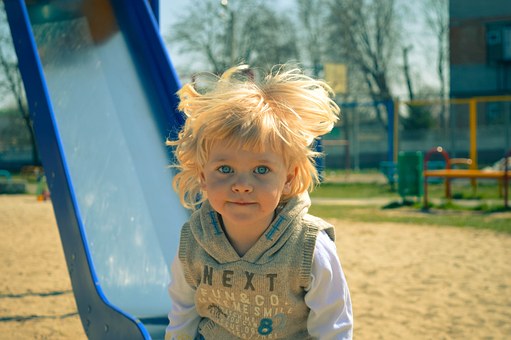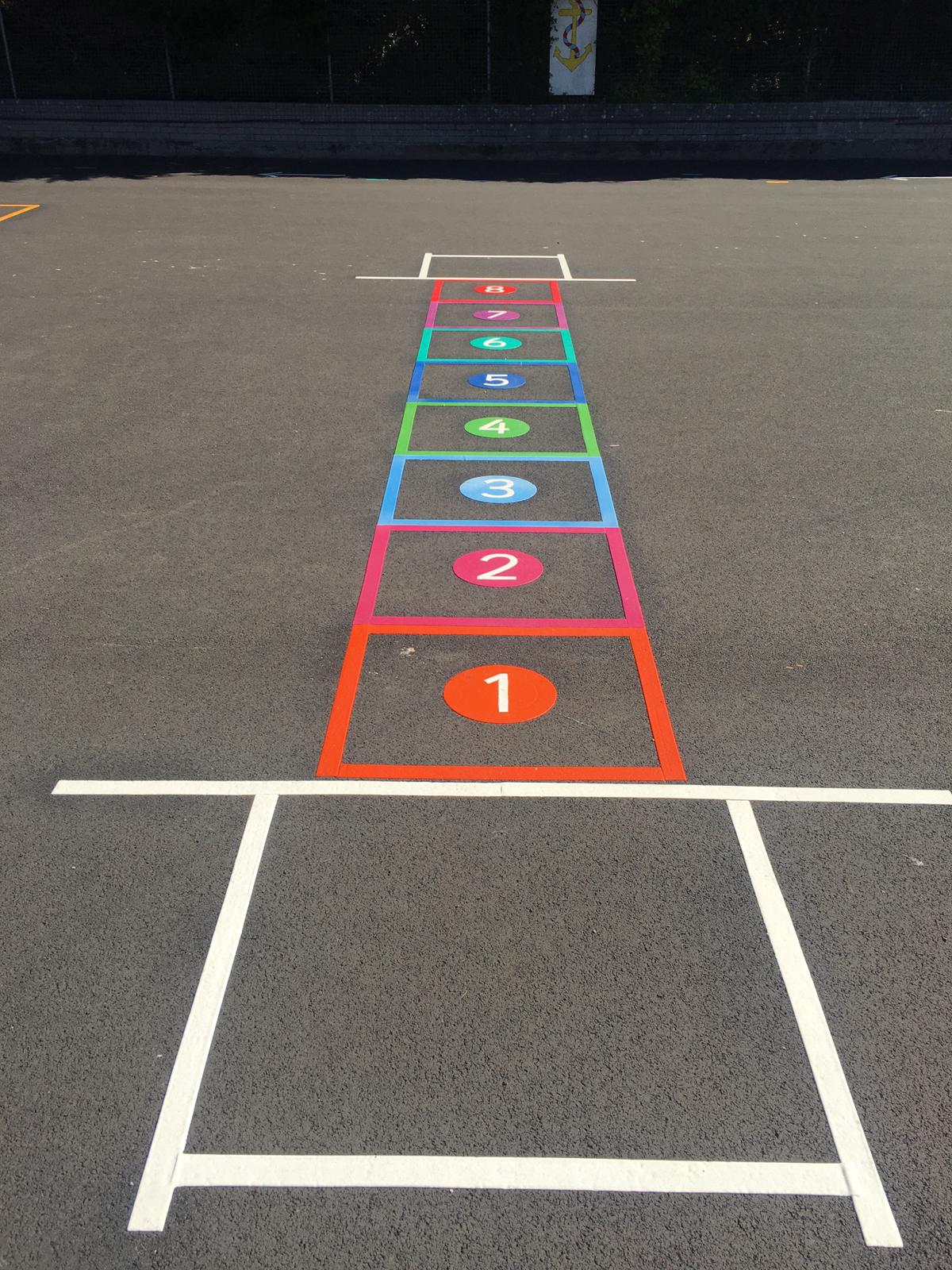Our Favourite “No Equipment” Playground Games
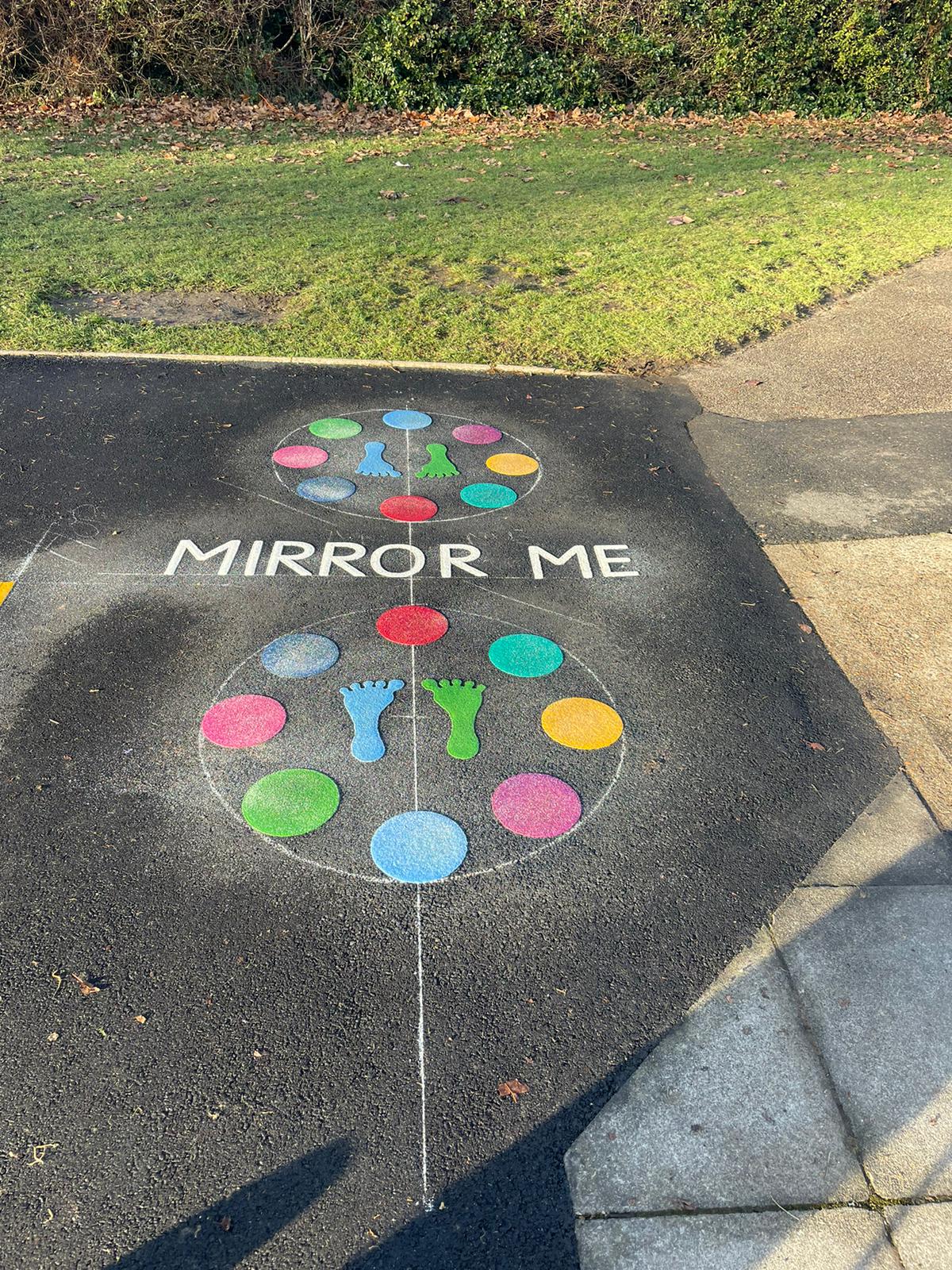

Keeping kids entertained and engaged during PE or break time can be tricky, especially when there’s little to no equipment available.
Whether you’re looking for easy playground games without any equipment for a quick break time activity or need something new for your KS2 class PE warm-up, this list has you covered.
Below, we’ve compiled 20 of our absolute favourite playground games, which either need very little or even no equipment at all to keep children active, social, and having fun.
“What’s the Time, Mr Wolf?”
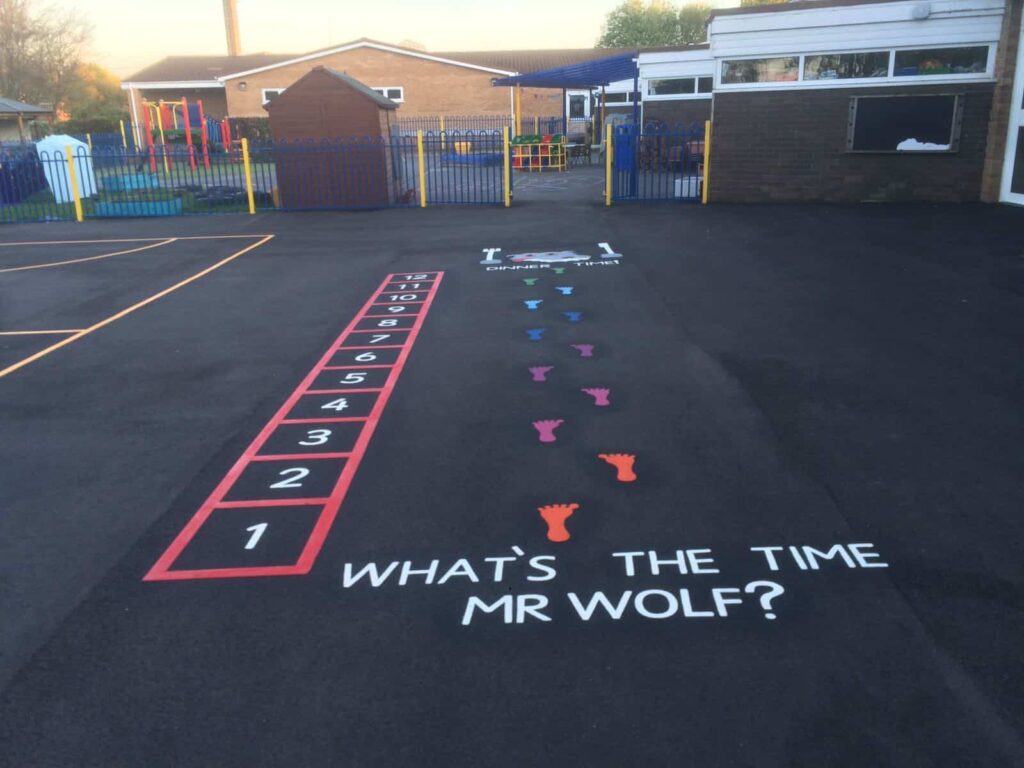
This is a fantastic choice for both KS1 and KS2 pupils; it’s simple to play, encourages active participation, and can be enjoyed in any outdoor play space. It also nurtures kids’ counting skills and agility, helping them to hone their reaction times.
How to Play:
- Choose one child to be “Mr Wolf.” They stand at one end of the playground, facing away from the other players. Ideally, this will be against a wall or a fence.
- The remaining children form a line at the opposite end and call out together: “What’s the time, Mr Wolf?”
- Mr Wolf replies with a time (e.g., “3 o’clock”). The players then take that many steps forward.
- This continues until Mr Wolf decides to shout “It’s dinner time!” instead of a number. At this point, they turn around and chase the players back to the starting line.
- If Mr Wolf tags someone before they reach safety, that person becomes the new Mr Wolf.
If you’ve got younger pupils in need of assistance with their steps or counting, you can always opt for markers in the shape of our Mr Wolf game.
Duck, Duck, Goose
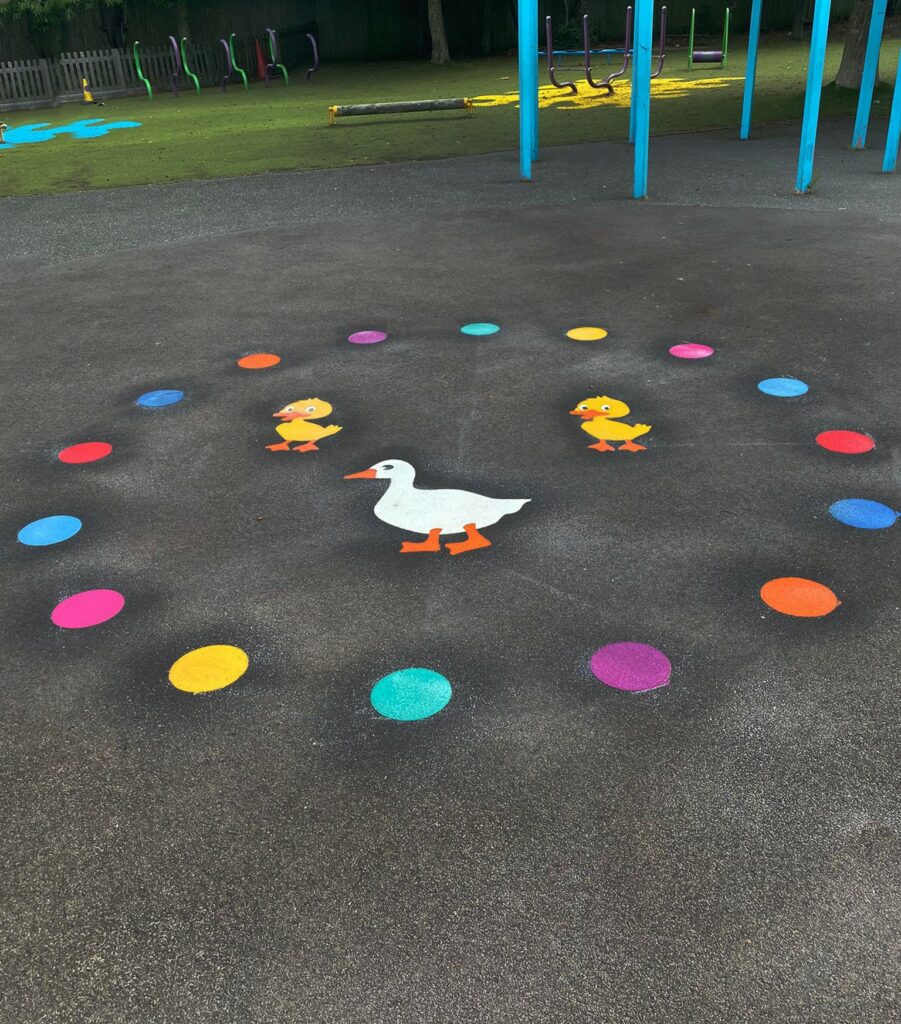
A timeless favourite and maybe the first game you’d think of when imagining playground games without equipment, Duck, Duck, Goose is an energetic and exciting activity that’s perfect for younger children. It encourages quick thinking, social interaction, and physical activity, making it an excellent addition to playtimes.
How to Play:
- Children sit in a circle, facing inward.
- One child walks around the outside of the circle, lightly tapping each seated child’s head while saying “duck” each time.
- When they decide, they tap a child and say “goose!” instead of “duck.”
- The “goose” must jump up and chase the tagger around the circle, trying to catch them before they reach the empty spot.
- If the tagger sits down before being caught, the “goose” becomes the new tagger. If the tagger is caught, they must sit in the middle of the circle until the next round.
If you’d like to dedicate the same space in your playground to Duck, Duck, Goose every time, you can always add playground markings to make it permanent.
Follow the Leader
A brilliant, easy playground game with no equipment, Follow the Leader is perfect for getting children moving while developing their coordination and listening skills. It’s an incredibly flexible game that can be played anywhere, with children of any age and ability.
How to Play:
- Choose one child to be the leader.
- The rest of the players form a line behind them.
- The leader begins moving in different ways – jumping, skipping, twirling, clapping, or even balancing on one foot.
- The children behind must copy the leader’s movements exactly as they move around the playground.
- After a few minutes, a new leader is chosen, and the game continues.
Traffic Lights
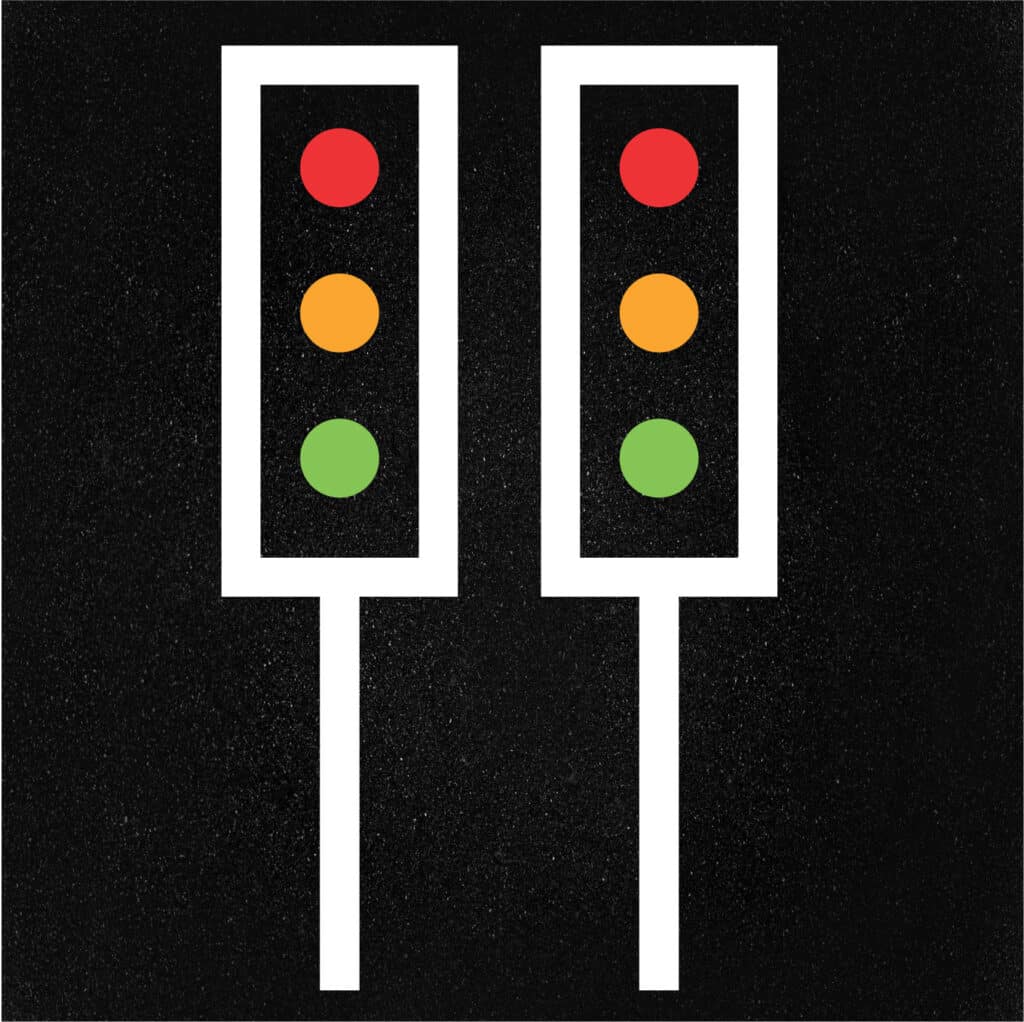
Traffic Lights is a brilliant game for developing children’s listening skills, reaction times, and agility. It’s easy to learn, requires no setup, and can be played in any size of outdoor space.
How to Play:
- One child is chosen as the “traffic light” and stands at one end of the playground, facing away from the group.
- The rest of the players line up at the opposite end, ready to move forward.
- The traffic light calls out different commands:
- “Green light” – Players move forward (walking, jogging, or running).
- “Yellow light” – Players must slow down to a walk.
- “Red light” – Players must freeze in place as the “traffic light” turns around.
- If a player keeps moving after “Red light” is called, they must return to the starting line.
Hopscotch
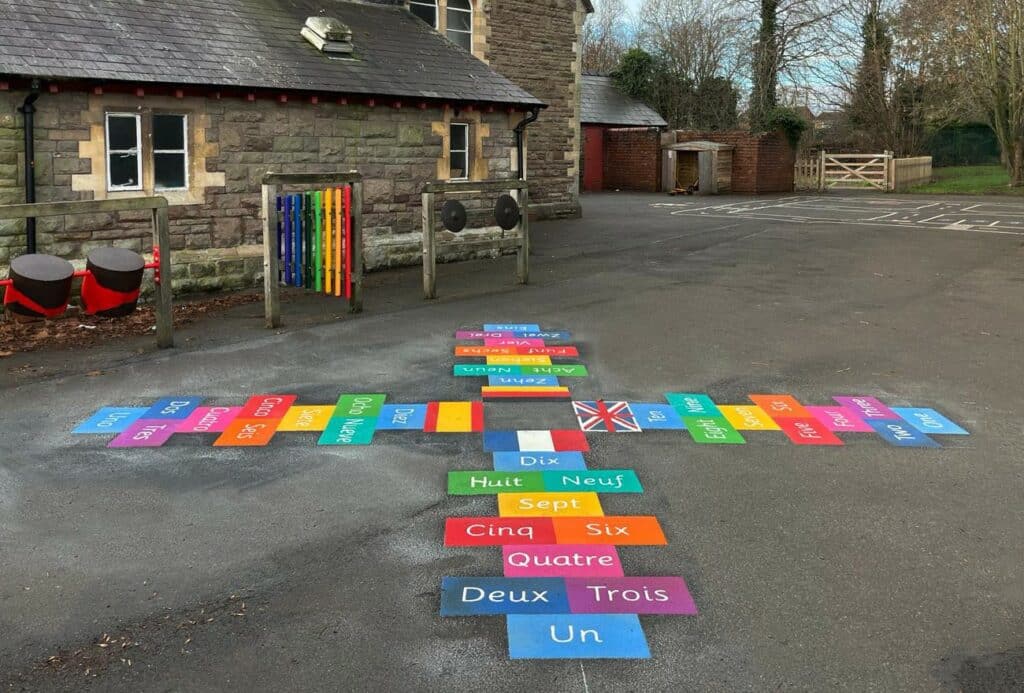
Hopscotch is one of the most well-loved playground games, helping children develop balance, coordination, and basic numeracy skills. It’s easy to play and works brilliantly on any playground that already has a painted hopscotch grid.
How to Play:
- Players take turns tossing a small object (such as a stone or beanbag) onto a numbered square.
- They must then hop through the grid, skipping the square where the object landed.
- Hopping must be done on one foot unless the grid has double squares, where both feet can be placed.
- Upon reaching the last square, the player turns and hops back, stopping to retrieve the object before finishing.
- If a player loses balance, steps on a line, or lands in the wrong square, their turn ends, and the next player goes.
- The goal is to complete all the numbered spaces while following the rules.
If your playground doesn’t already have a Hopscotch grid, we have a whole host of designs for you to choose from!
Mirror Me
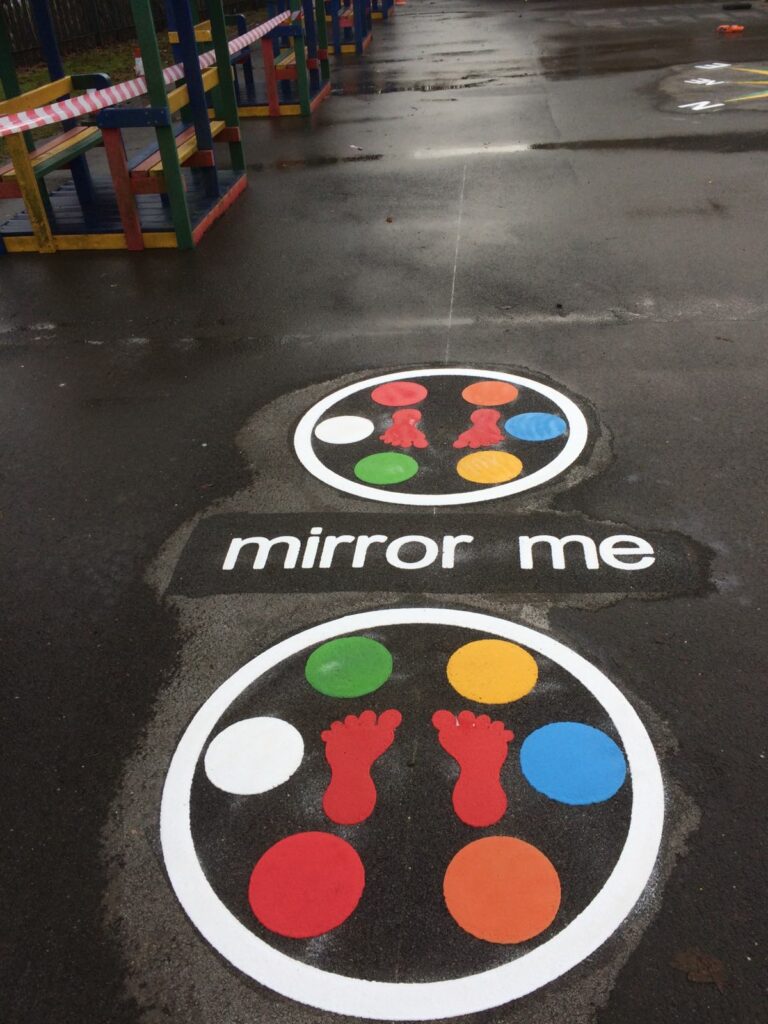
Mirror Me is perfect for PE warm-ups, morning energisers, or brain breaks throughout the school day. It encourages children to focus, improve their coordination, and develop social interaction skills in a fun and engaging way.
How to Play:
- One child or a teacher is chosen as the leader and stands in front of the group.
- The leader performs a movement such as jumping, clapping, stretching, or balancing on one leg.
- The rest of the players must copy the movement exactly, acting as if they are looking into a mirror.
- After a few movements, the leader chooses another child to take their place.
- The game continues, with different children getting a chance to lead.
You might have a small spot in your playground where you think Mirror Me could always be played by small groups. If so, our Copy Me playground markings are ideal. For larger groups, you might even want a Dance With Me.
The Maths Run
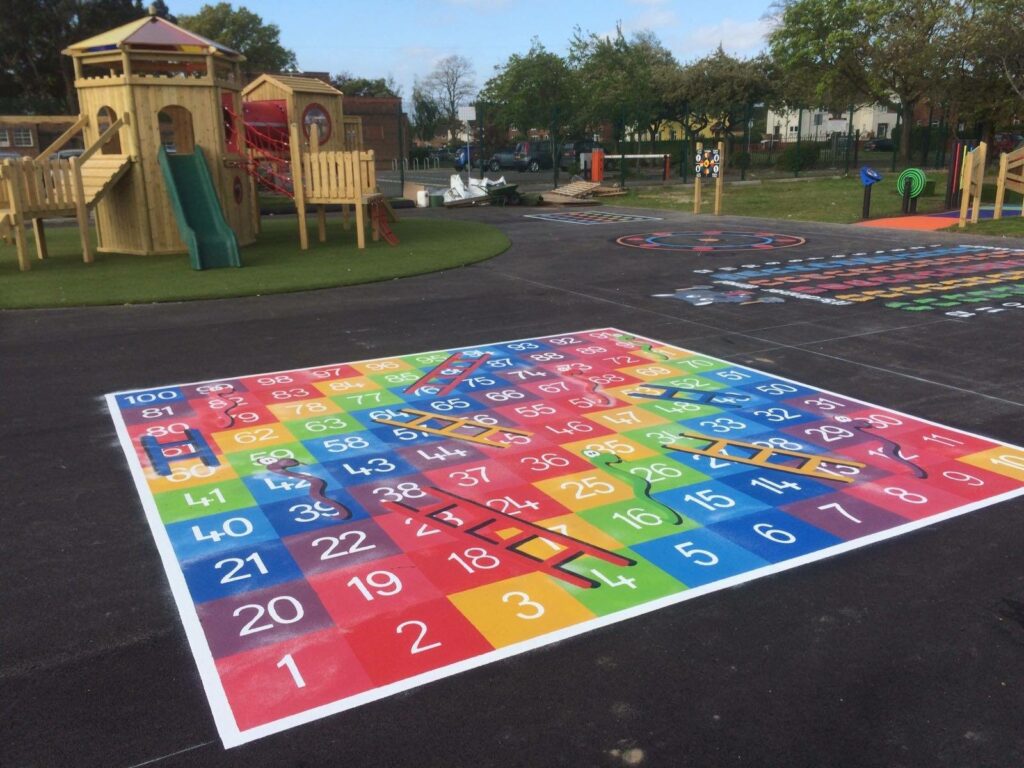
A great way to make learning active, Maths Run combines numeracy skills with physical exercise, making it a great choice for PE, brain breaks, or outdoor learning sessions. If you’ve already got a numbered Grid or multiplication chart on your playground, or you have cones or markers with numbers already on them, you even have everything you’ll need.
How to Play:
- Children start by standing a short distance away from a number grid or multiplication square (or, if no markings are available, teachers can designate different spots on the playground for numbers).
- The teacher calls out a maths question appropriate for the children’s age group (e.g., “What is 5 + 4?” or “What is 7 x 6?”).
- Players must quickly run to the correct answer and stand on or point to it.
- The fastest child to reach the correct answer wins a point (or can be the next caller).
- The game continues with new questions, allowing all children to get involved and build their confidence in maths.
The Spelling Race
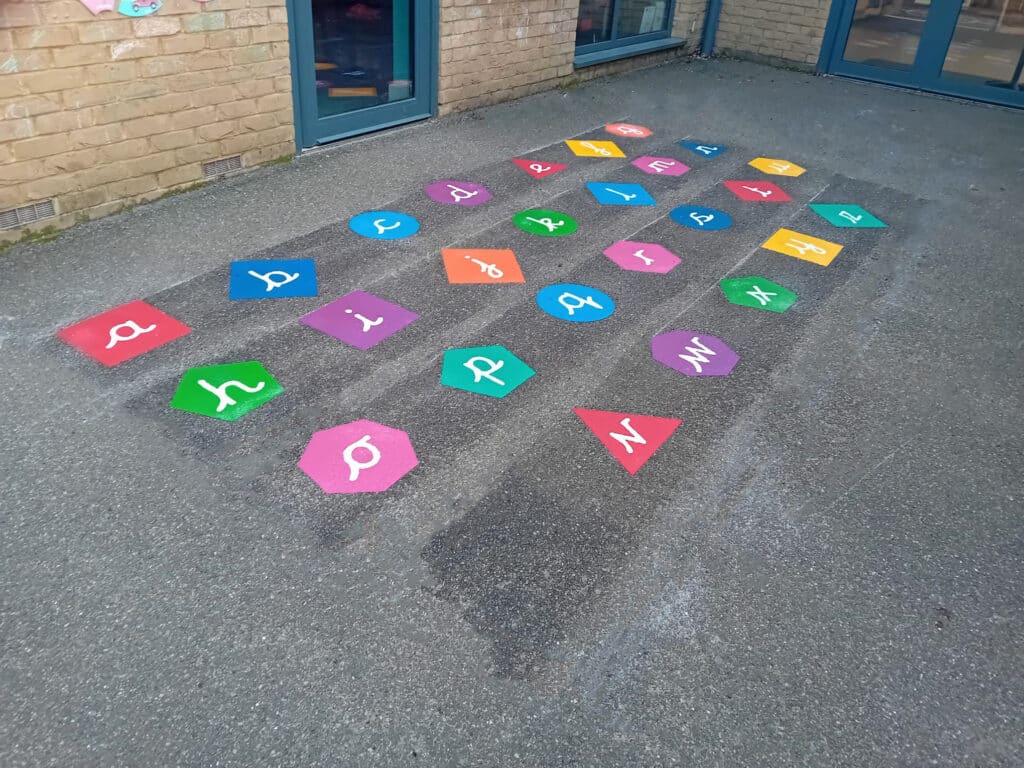
A fun and active way to reinforce spelling skills, Spelling Race turns literacy into an exciting playground challenge. It’s a great option for KS2 pupils, encouraging them to think quickly, and stay physically active, and giving them the chance to practise harder words.
Much like the Maths Run, you will be all set if you have an Alphabet already present in your playground, or cones or markers you can use with letters on them.
How to Play:
- Players begin by standing a short distance from an alphabet grid or designated letters drawn in chalk.
- A teacher or friend calls out a word (e.g., “Cat” or “Elephant”).
- Players must race to step on or touch the letters in the correct order to spell the word.
- The fastest child to spell the word correctly earns a point or takes the next turn as the caller.
- The game continues with new words, helping to improve letter recognition, spelling confidence, and speed.
Relay and Activity Races
Relay races are a brilliant way to get children moving while encouraging teamwork, speed, and coordination. While traditional relay races often involve batons, bean bags, or balls, they can easily be adapted into playground games with no equipment, making them ideal for PE lessons or break-time fun.
How to Play:
- Split the class into equal teams and have them line up behind a designated start line.
- Mark out a running distance using existing playground features (e.g., painted lines or cones if available).
- The first runner in each team sprints to the designated marker and back.
- Instead of passing a baton, they high-five or tag the next runner, who then takes their turn.
- Make the runs more interesting by incorporating different activities, such as hopping, jumping, or skipping.
- The race continues until all team members have completed their legs, and the first team to finish wins!
Our collection of Fitness playground markings even includes Activity, Agility, and Adventure Trails, if you’d like to add an extra layer of challenge.
Animal Movements
This is a fun and engaging way to encourage physical activity and imaginative play. It’s perfect for PE warm-ups, brain breaks, or general outdoor play, helping children develop coordination, balance, and gross motor skills while having fun.
How to Play:
- The teacher or a chosen player calls out the name of an animal (e.g., “Frog!” or “Elephant!”).
- All players must move like that animal—for example:
- Frog – Squat and jump forward.
- Kangaroo – Hop with both feet together.
- Snake – Slither or wriggle on the ground.
- Elephant – Stomp slowly while swinging an imaginary trunk.
- Bird – Flap arms and run around.
- The teacher calls out a new animal every 20-30 seconds, keeping the game fast-paced and exciting.
- You can make it competitive by eliminating players who don’t follow the actions correctly, or keep it inclusive and fun for all.
Shadow Tag
This is a great playground game with no equipment that challenges children to be quick, observant, and strategic. Perfect for sunny days, this game encourages movement and awareness while providing an exciting alternative to an ordinary game of tag.
How to Play:
- One player is chosen as “It” and must try to tag others – not by touching them, but by stepping on their shadow.
- The other players move around the playground, dodging and shifting to keep their shadows away from “It”.
- If “It” successfully steps on someone’s shadow, that player becomes the new “It”.
- The game continues for as long as players want, keeping everyone active and engaged.
Catch the Dragon’s Tail
Catch the Dragon’s Tail is perfect for large groups, encouraging teamwork, strategy, and agility. It’s fast-paced, exciting, and keeps everyone involved from start to finish.
How to Play:
- Players stand in a single-file line, holding onto the waist of the person in front of them. This forms the dragon, with the first child being the head and the last child being the tail.
- The goal is for the dragon’s head (the first player) to catch the tail (the last player) while the rest of the line tries to stop this from happening—without breaking the chain!
- The dragon’s body (all the players in the middle) must work together, twisting and turning to protect the tail while staying linked.
- If the head successfully tags the tail, the tail player moves to the front, becoming the new head, and the game continues.
Hide and Seek
An absolute classic in the world of children’s games, Hide-and-Seek is simple, fun, and encourages strategic thinking and teamwork, especially when playing variations like Sardines.
How to Play:
- One player is chosen as the seeker and closes their eyes while counting to an agreed number (e.g., 20 or 30).
- The rest of the players find hiding spots within a designated area.
- Once the seeker finishes counting, they search for the hidden players.
- The last person found becomes the new seeker, and the game resets.
How to Play Sardines:
- Only one player hides, while everyone else is a seeker.
- When a seeker finds the hidden player, they quietly join them in hiding.
- The game continues until all but one player is crammed into the hiding spot – like a tin of sardines!
- The last seeker to find the group loses the round and becomes the new hider.
Hand Clapping Games
Though not as physically active as some other playground games, clapping games play a crucial role in developing rhythm, coordination, and teamwork. Simple yet engaging, they’ve been passed down through generations and remain popular in playgrounds today.
How to Play:
- Players face each other and clap in rhythm, following a specific pattern.
- Some games include singing rhymes or chanting lyrics while keeping the rhythm.
- The game continues until a mistake is made. The first player to break the rhythm or miss a clap loses.
- In group versions, players can rotate partners after each round to keep the game fresh and engaging.
Want more ideas? We’ve put together a list of 15 easy hand-clapping games to help you get started. Why not teach your pupils a few and see which ones they love the most?
Simon Says
This is one of the best and most fun games to play without any equipment at all, helping children develop listening skills, quick thinking, and coordination. It’s simple to set up, can be played anywhere, and is great for KS1 and KS2 pupils.
How to Play:
- One player is chosen as “Simon” and stands in front of the group.
- Simon gives commands such as “Simon says touch your toes” or “Simon says hop on one foot.”
- Players must only follow commands that begin with “Simon says.”
- If Simon gives a command without saying “Simon says” first (e.g., “Jump in the air”), anyone who follows the instruction is out.
- The last player remaining becomes the new Simon.
Elves, Wizards, and Giants
A fun, active twist on Rock, Paper, Scissors, Elves, Wizards, and Giants is a brilliant playground game with no equipment that gets children thinking strategically while keeping them active. It’s perfect for KS2 pupils, encouraging teamwork, decision-making, and quick reflexes.
How to Play:
- Split the players into two equal teams and have them stand in separate lines, facing each other.
- As a team, players secretly decide which character they will be:
- Elves – Crouch low with hands near ears (like pointy elf ears).
- Wizards – Wave arms as if casting a spell.
- Giants – Stand tall with arms raised.
- On the count of three, both teams reveal their choice at the same time.
- The winning team chases the losing team to a designated safe zone.
- Any player tagged before reaching safety joins the other team, and the game continues.
Who Beats Who?
- Elves beat Wizards (Elves are too fast for Wizards).
- Wizards beat Giants (Wizards use magic to defeat Giants).
- Giants beat Elves (Giants are too powerful for Elves).
The Floor is Lava
A favourite among children, The Floor is Lava is a fantastic playground game with no equipment that sparks creativity while keeping kids active. This game encourages quick thinking, balance, and agility, making it perfect for both free play and structured PE sessions.
How to Play:
- Players imagine that the entire playground floor is lava, except for certain “safe spots.”
- The teacher or a selected leader calls out “The floor is lava!” at random moments, and all players must jump onto a safe spot as quickly as possible.
- Safe spots can be anything from stepping stones, coloured playground markings, agility trails, or even benches.
- Any player caught standing in the lava is out for that round or must perform a fun challenge (e.g., jumping jacks) before rejoining.
- The game continues as players move around, waiting for the next lava warning to be called.
Having a series of Stepping Stones in your playground would complement this game nicely.
Maze Challenges
Maze challenges turn your playground into an interactive puzzle. While this game is best played with a painted playground Maze, it can also be adapted as a playground game with no equipment by marking out paths using chalk or imaginary boundaries.
How to Play:
- Players start at the entrance of the playground maze and must navigate to the exit as quickly as possible.
- The teacher or game leader can introduce extra challenges to make it more exciting, such as:
- Directional commands: Players can only move in the directions called out (e.g., “Left!” “Right!” “Forward!”).
- Memory challenges: Players must remember a specific route given before they start.
- Riddle stations: To proceed to the next section, players must answer a maths or spelling question correctly.
- The first player to reach the exit wins, or players can race against the clock to beat their personal best time.
Sharks and Minnows
A fast-paced and exciting game, Sharks and Minnows is a fantastic way to get children moving while improving speed, agility, and quick thinking. It’s ideal for KS2 pupils, as it requires both strategy and fast reactions.
How to Play:
- One player is chosen as the “shark” and stands in the middle of the playground.
- The rest of the players (the “minnows”) line up at one end of the play area.
- When the shark shouts “Go!”, all the minnows must run to the other side without being tagged.
- Any minnow who is tagged becomes a shark and joins the middle for the next round.
- The game continues until only one minnow remains, who is declared the winner and can start as the new shark in the next round.
Capture the Flag (No Flag Version)
Capture the Flag encourages speed, agility, and tactical thinking. This no-equipment version keeps all the excitement of the traditional game while making it easier to play anywhere, with no need for physical flags.
How to Play:
- Split the players into two equal teams and assign each team a safe zone at opposite ends of the playground.
- The goal is for players to reach the opponent’s safe zone without being tagged by the opposing team.
- If a player successfully reaches the opponent’s zone, they score a point and must run back to their side.
- If a player is tagged before reaching the zone, they must return to their side before trying again.
- The game continues for a set time, and the team with the most successful runs wins!
Make a Permanent Place for No-Equipment Games
With our high-quality playground markings, you can bring these no-equipment playground games to life with bright, long-lasting designs that enhance playtime, learning, and exercise. Whether it’s hopscotch, mazes, number grids, or agility trails, our markings provide a permanent place for children to enjoy structured and imaginative play every day.
Our team offers free site surveys, expert installation, and tailored playground layouts to suit your space and needs. Get in touch today to transform your school’s outdoor area into an exciting hub for active play!


